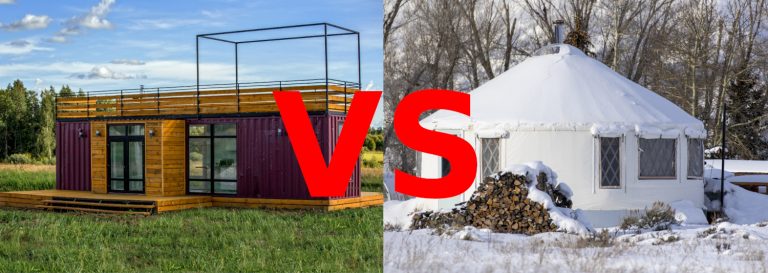Do Container Homes Rust?
Container homes have a lot of advantages. They are affordable, easy to build, and environmentally friendly. They are also very sturdy as they are made from quality steel and built to last, but how susceptible are they to corrosion?
Container homes do rust. Most rust will be surface rust, as shipping containers are made from a rust-resistant alloy, however, pockets of water can accelerate the process and cause structural damage within a few years.
Container homes are generally very durable compared to many other home types, but they do need some care. If good preventative measures are taken, your home should be able to last for several decades without extensive maintenance.
Container Homes do Rust
Nearly all shipping containers are made from a type of steel called corten steel, also known as weathering steel. Corten is a contraction of corrosion resistance and tensile strength. It is a steel alloy that was developed by U.S. Steel and originally intended for railway wagons.
Corten steel is developed to form a layer of rust on the surface that will protect the steel below it from corroding too fast – similar to the chemical process that makes copper roofs so durable. This way a container will not have to be scrapped because of a few scratches in the paint.
This means that shipping containers are very rust-resistant, and they can last for years on board cargo ships. But they are not rustproof. The protective layer only delays the inevitable, and over time unmaintained containers will corrode, leading to structural damage. A typical shipping container will be in use for 10 to 12 years, but you want your home to last a lot longer, so you need to protect it from any kind of corrosion beyond surface rust.
The steel is particularly prone to corrosion in areas where water accumulates, such as inside dents and on the corrugated roof, where water may not run off. This is usually where the real degradation process happens.
How to Prevent Corrosion
There are several things you can do to keep your container home from corroding. The primary being keeping a watchful eye.
Make sure to look for dent, scratches, flaking paint, and early signs of rust. Especially around the roof, on side rails, where two containers have been joined together, and any other places where water can accumulate in pockets. Early signs are much easier to treat than at later stages.
Paint It
Some people prefer the rough look of rusty metal, in which case you should remove the existing paint to allow an even patina to develop all over the container. Just know that when this surface rust has gained traction, it will be a huge (possibly impossible) job to remove if you later change your mind and decide to paint it. And, although they are built to last, they will eventually corrode through.
If you prefer a more “clean” surface and a longer-lasting home, you will need to paint it. This may be the primary reason why you would ever consider buying a new container that has already been painted because doing it yourself is quite a job.
Remove Water and Snow From the Roof
As the roof is the largest horizontal area of your container home, there will be many places for water to accumulate. And not only does the corrugated surface make efficient drainage difficult, but there may also be dents from its previous function as a shipping container or from storm debris.
Make sure rainwater can run off the roof. Dents should be patched or at least painted with a thick coat. Consider lowering one side of the roof a little for more efficient drainage, and add gutters to keep the water from running down the side of your home and on to the bottom side rails.
Remove snow from your roof. A downside of using containers as a building material is that they are built to withstand a lot of pressure on the four support beams in each corner, but not much on the roof itself. Snow is heavy, and while a thick layer of snow probably will not cave in on you, it can cause the roof to bend inwards, causing a dent in which melted snow and rain will accumulate.
You can also place a support beam in the middle of the container to keep the roof from bending in the middle over time. Even a slight bend will lead to water accumulating on your roof.
Place It on a Foundation
Humidity from the ground can turn into a nightmare for unprepared container owners. While you can easily keep an eye on the roof, you will not be able to see the rust under the base of the container until there’s a hole in your floor.
Therefore, it’s highly recommended to place a container home on a foundation, such as a concrete slab or strip foundation, to keep it off the ground. Even if you only use one container. If the slab is bigger than the container, make sure it has a slight outward lean so the rainwater will run away from it.
Use Ventilation and Isolation
While we may primarily worry about rust on the outside of the container, we should also take a few important steps to prevent it from occurring on the inside. This is especially true when we live in it, as we exhale water vapor and use a lot of water in our daily routines.
Make sure there is sufficient ventilation in your home by installing vents. Ventilation is important throughout the home, but it is particularly important in places where we:
- sleep
- shower
- cook
Insulation is also a crucial part of every home, and particularly in a steel home. Adding insulation to the walls, floor, and roof will lower the cost of heating and cooling your home, and it will protect the inside of the container from accumulating condensation. Make sure to use a vapor barrier.
Don’t Worry Too Much about Corrosion
While it’s important to take maintenance seriously, don’t fret too much. Most rust can be fixed. Surface rust can be removed and painted over. More badly corroded areas will need to be cut off and replaced. Both of these tasks should usually be done by an experienced metal worker and can cost a bit. But unless the damage is extensive, it doesn’t mean your home needs to be scrapped.






